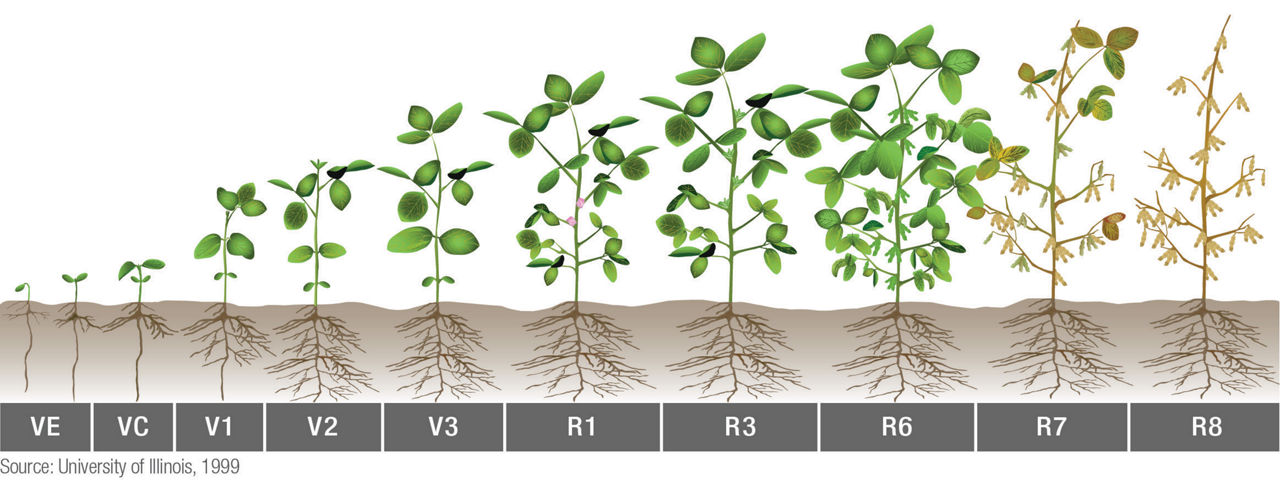How to Determine Which Fungicide to Use and When
July 26, 2023
Protection from foliar crop diseases is paramount for maximizing yield and grain quality. A fungicide application may assist in the protection of yield and profit loss by potentially reducing diseases on corn or soybean. Fungicides are pesticides that prevent, kill, mitigate, or inhibit the growth of fungi on plants, but they are not effective against bacteria, nematodes, or viral diseases.1 Correct identification of corn and soybean diseases is key for determining if a fungicide is warranted and used appropriately.
To help identify and understand corn and soybean diseases, please see Identifying Key Diseases in Corn and Watching for Soybean Diseases? Remember these Key Signs
After determining a foliar fungicide is necessary, the optimum timing of the application is crucial. Understanding crop growth stages and the environmental factors necessary for each fungal disease helps in the application timing and process. After planting, continuous scouting should be conducted to identify any developing diseases, determine if environmental conditions necessary for disease development are present, and determining the appropriate soybean or corn growth stages for fungicide application.
Fungicide Application Factors
- Crop susceptibility:
- Corn and soybean products vary in disease susceptibility, resistance, or tolerance. Scouting, especially for susceptible products, should be an ongoing activity after seedling emergence to help identify potential disease issues.
- The critical timing for disease scouting is prior to tasseling in corn and beginning flowering for soybean.
- High Risk Fields:
- Irrigation, late or early planting, high plant density, and high yield potential are factors that can increase the risk of disease development.
- Corn fields with 35% or more residue, including those with continuous corn, no-till, and reduced tillage combined with a history of foliar diseases should be scouted regularly since many foliar diseases survive on corn residue and begin producing spores when wet weather favors development.2
- In continuous soybean operations, residue can harbor disease pathogens from year to year, and some pathogens such as white mold can exist for several years in the soil.
- Weather Conditions:
- Most diseases favor high relative humidity and wet conditions, whereas temperature is more dependent of the individual fungal pathogen. Understanding the favorable conditions for each fungal disease is essential.
- Anticipated weather conditions that favor infection may warrant a fungal application or subsequent applications.

- Growth Stages/Fungicide Timing:
- Corn - In most cases, fungicides should be applied at or after tasseling. A general guideline for susceptible or moderately susceptible corn products may be to spray when disease symptoms have developed on the third leaf below the ear leaf or higher leaves on 50% of the plants at tasseling stage.3 If fungicide application is warranted, generally the greatest benefit comes from a single application at tasseling (VT) through silking (R1) growth stages.4 Figure 1 shows application timings for Delaro® 325 SC Fungicide and Delaro® Complete Fungicide in corn to manage Tar Spot.
- Soybean - Fungicide applications in soybean should be considered at beginning bloom (R1 growth stage) into beginning pod (R3 growth stage), depending on the foliar disease (Figures 2 and 3). For example, initial infection of white mold or sclerotinia stem rot often occurs at R1; therefore, the first fungicide application should occur at R1 and if necessary, a second application at R3.5 The best timing for an fungicide application for other foliar diseases, such as Septoria brown spot, Cercospora leaf blight, and frogeye leaf spot, is around R3.5 An additional application may be necessary at a later growth stage, depending on the disease severity and timing. However, fungicide applications made after R5 (beginning seed) growth stage or prior to R1 (beginning flower) growth stage are often not economical.6


Fungicide Efficacy/Which Fungicide to Use
Once the disease and the above-mentioned fungicide application factors are identified, contact your Bayer Crop Protection Specialist for optimum recommendations. They can provide information on the efficacy of the fungicide when paired with the disease, the appropriate applications of the labeled rates, and other use considerations.
Final Thoughts
Fields should be scouted to correctly diagnose the fungal disease. Fungicides are not effective against bacterial and viral infections. Knowing when and how often to apply a fungicide is important. When ready to use the recommended fungicide for the diagnosed fungal disease, read the label and follow instructions. This not only helps protect the crop but helps protect your health and the environment. Remember always to apply fungicides using the appropriate equipment at the recommended application rate.1
Fungicide labels provide information on recommended use, ingredients, mode of action, and formulation of the product. For more information, please see What You Need to Know about Reading a Pesticide Label.1
Lastly, use multiple modes of action to get the most comprehensive control and to protect your farm from resistance issues.
Dawn Gustafson
Channel Technical Agronomist
Sources
1Salamanca, L.R. and Saalau, E. 2018. Fungicides and how to use them effectively. Horticulture and Home Pest News. Extension and Outreach. Iowa State University. https://hortnews.extension.iastate.edu/2018/07/fungicides-and-how-use-them-effectively/.
2Anderson Onofre, K. and Jardine, D. 2020. Fungicide considerations for corn diseases: Scouting is key. Agronomy eUpdates. Kansas State University. https://eupdate.agronomy.ksu.edu/article_new/fungicide-considerations-for-corn-diseases-scouting-is-key-396-1/.
3Robertson, A., Abendroth, L., and Elmore, R. 2007. Yield responsiveness of corn to foliar fungicide application in Iowa. ICM News. Integrated Crop Management. Iowa State University. Extension and Outreach. https://dr.lib.iastate.edu/server/api/core/bitstreams/d7dfa238-16ec-4419-b1ee-78e1c9d7f247/content/.
4Hershman, D.E., Vincelli, P., and Kaiser, C.A. 2011. Foliar fungicide use in corn and soybeans. Plant Pathology Fact Sheet. PPFS-GEN-12. University of Kentucky. https://plantpathology.ca.uky.edu/.
5Strunk, C. and Mathew, F. 2022. Mid-to-late soybean disease management. South Dakota State University. https://extension.sdstate.edu/mid-late-soybean-disease-management/.
6Mueller, D., Robertson, A., and Pedersen, P. 2006. Asian soybean rust management strategies. PM2028. Iowa State University.
Websites verified 5/15/23. 1110_274451